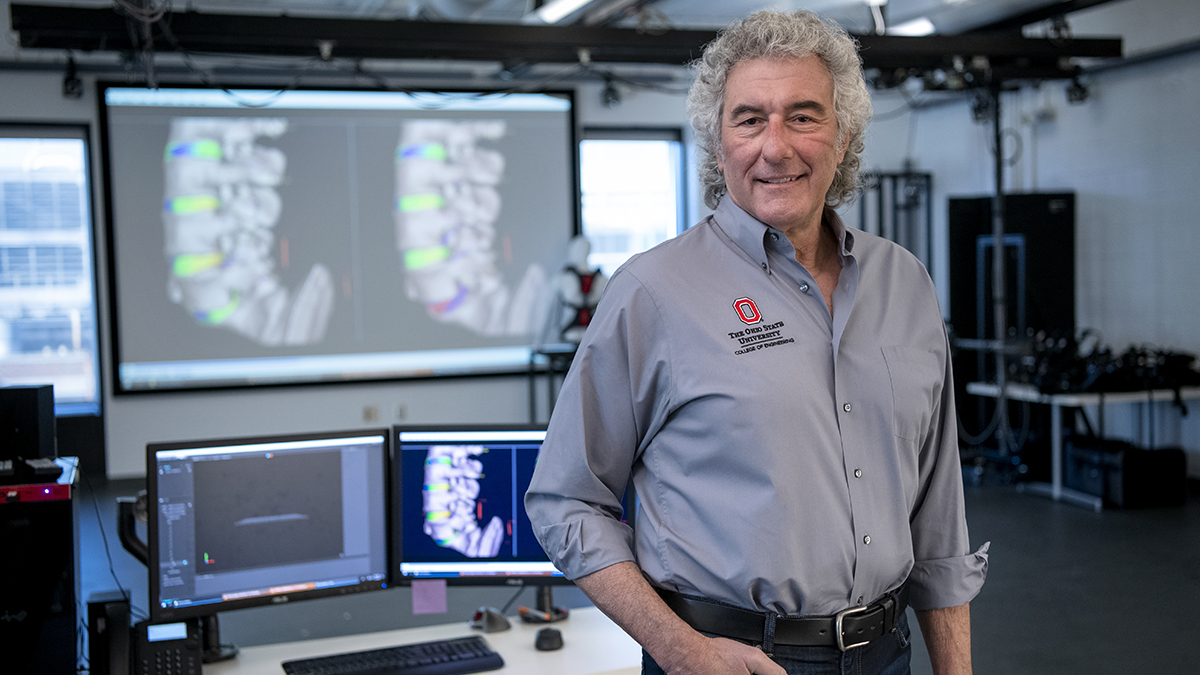Convergence creates innovation
Marras offers a multi-disciplined attack to help doctors pinpoint back pain solutions

Before William Marras welcomes students to his research team, he inspires them with a challenge.
“I tell my students, ‘I’m not going to take you on unless I can learn from you,’” the director of the Spine Research Institute (SRI) said. “[While] you’re going to study with me, you will become the world’s expert in a particular area. And you’re going to teach me.”
Once you understand Marras’ research mindset, his game plan makes perfect sense. He knows that true innovation requires fresh ideas and nimble minds – particularly when you’re trying to understand a mechanism that has baffled mankind for centuries: the human spine.
Today, back pain is the most debilitative condition worldwide, affecting more than 1.3 billion people. In the United States, the painful affliction causes more than 100,000 workdays to be lost and $100 billion in expenses to treat. It’s also the No. 1 reason people take opioids.
Why is back pain such a difficult problem to treat? For one, we barely understand what causes a person’s unique version of back pain.
However, Marras’ research is giving physicians the ability to identify the cause of pain and develop personalize treatments. But he’s not doing it on his own.
In fact, that’s his formula.
Convergent research
Back pain is complex, so Marras relies on a convergent approach to research – attacking particularly challenging societal problems through a multi-disciplined, collaborative approach to discovery and innovation.
At Ohio State, Marras said he benefits from a campus full of experts and collaborators, including a close one between the College of Engineering and the College of Medicine. On a given day, his team works with mechanical engineers, ergonomic engineers, orthopedic surgeons, physical medicine and rehabilitation specialists, mathematic modelers, neurosurgeons and anesthesiologists.
Along with such expertise, Marras has a wealth of resources at his fingertips, including incredible diversity of thought, backgrounds and ideas. It’s that diversity that makes up his team of grad students and full-time researchers who are largely former grad students.
“Diversity is where the best ideas come from, once you embrace that you get great results,” Marras said. “We have a tight-knit team who think openly. When you have that, you get a melting pot of creativity.”
It’s that creativity that innovates.
Unlocking innovation
Marras’ convergent approach has tangible results. An example of this is the creation of wearable back sensor technology, which helps create a computer model of someone’s spine and bring an MRI to life with greater precision in imaging the spine and pinpointing pain areas.
The idea came about when his team was brainstorming how to capture the ways a person’s spine moves in a workplace.
“Somebody just said, ‘Let’s use a cadaver spine and put sensors up and down and strap it onto a person,’” Marras said. “We all had a good laugh but then we thought it wasn’t a bad idea.”
The team built a replica of a spine for its first embodiment of the wearable sensor technology.
Technology that heals
The wearable sensor technology not only helps pinpoint potential individual back pain sources for personalized care, but it is also being used to build a digital health computer platform that provides data-driven information to help physicians evaluate and treat patients accurately.
It’s called the Spine Phenome Project. The project is part of BACPAC (Back Pain Consortium Research Program), which is under a National Institutes of Health initiative called HEAL (Helping to End Long-Term Addiction), an effort to find solutions to opioid addiction. Because back pain is rarely understood and treated correctly, sufferers often turn to pain killers. Proper treatment could end that.
Marras has helped a wide array of industries develop workplace interventions to prevent back injuries from happening. His work with Honda alone has reduced injury rates on work lines by over 90%.
“The No. 1 reason people take opioids is for back pain, and we’re determined to find a better way to relieve people’s suffering without having to rely on opioids,” Marras said.
Marras’ research is being recognized. His work has received FDA Breakthrough designation, meaning the FDA (the U.S. Food and Drug Administration) will work to fast-track the development to market.
“What gets me up every day is knowing we’re doing something that makes a difference,” he said. “Interacting with really bright people every day gets me energized. “I’m able to do things here at Ohio State that I cannot imagine having the opportunity to do anywhere else. It’s because of the attitudes and the diversity and having the right people who get it.”
“People here care, and they understand our mission to help society. That makes it possible to do this.”